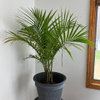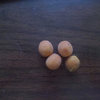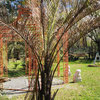Asian Cycad Scale
mandi_s1
16 years ago
Related Stories

BATHROOM DESIGN20 Ways to Design an Asian-Style Bathroom
Want a bathroom that’s inviting and serene, with spa-like luxury? Be inspired by these Asian-style spaces, which offer all that and more
Full Story
BATHROOM WORKBOOKBathroom Workbook: 13 Elements of Asian Style
Create a soothing, spa-like bath with simple materials and a deep connection to nature
Full Story
LOFTSHouzz Tour: Asian Elegance With an Industrial Edge
Once a grocery warehouse, this Denver loft is now stocked with a mix of dramatic, raw and refined pieces
Full Story
BEFORE AND AFTERSAsian Style Banishes Boredom in a Bachelor's Bedroom Makeover
Beige walls and lost-looking furniture give way to a warm but masculine look with sublime natural light
Full Story
HOUZZ TOURSMy Houzz: Many Styles Meld Handsomely in a Vermont Countryside Home
With a traditional exterior, a contemporary interior and lots of Asian furniture, this home goes for the element of surprise
Full Story
WORLD OF DESIGNSee 90 of Singapore’s Best Designs on Houzz
To celebrate the launch of Houzz Singapore, enjoy some of the Asian island’s stunning architecture and interiors
Full Story
HOUZZ TOURSMy Houzz: Treasures from Thailand
Escape to Southeast Asian paradise in this Florida family home with handpicked, exotic touches
Full Story
DECORATING GUIDESTable + Lamp: 10 Perfect Pairings
No more dithering over scale and style. We take the guesswork out of matching lamps to credenzas, coffee tables, nightstands and more
Full Story
LIVING ROOMSRoom of the Day: Dividing a Living Area to Conquer a Space Challenge
A new layout and scaled-down furnishings fill the ground floor of a compact Dublin house with light and personality
Full Story
Sponsored
More Discussions










houstonpat
mandi_s1Original Author
Related Professionals
Reading Landscape Architects & Landscape Designers · Graham Landscape Architects & Landscape Designers · Otsego Landscape Architects & Landscape Designers · Galveston Landscape Contractors · Indianapolis Landscape Contractors · McLean Landscape Contractors · San Bruno Landscape Contractors · South Lyon Landscape Contractors · Tamarac Landscape Contractors · Vacaville Landscape Contractors · Wentzville Landscape Contractors · Weymouth Landscape Contractors · Marinette Window Contractors · Poinciana Window Contractors · Redwood City Window Contractorsdbrya1
topher2006
cycadjungle
houstonpat
mandi_s1Original Author
cycadjungle
protempsfish
cycadjungle
houstonpat
don_licuala
gardenspider09
cycadjungle
xerophyte NYC
cycadjungle
gardenspider09